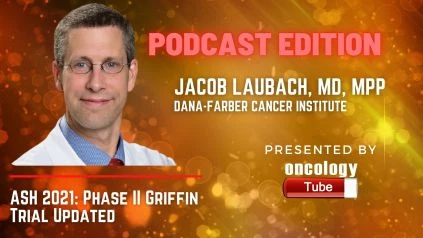Jacob Laubach, MD, MPP from the Dana-Farber Cancer Institute speaks about the ASH 2021 Abstract – 79 Daratumumab (DARA) Plus Lenalidomide, Bortezomib, and Dexamethasone (RVd) in Patients (Pts) with Transplant-Eligible Newly Diagnosed Multiple Myeloma (NDMM): Updated Analysis of Griffin after 24 Months of Maintenance.
Link to Abstract:
https://ash.confex.com/ash/2021/webprogram/Paper149024.html
Introduction:
DARA is approved for NDMM and MM that have been previously treated. DARA plus RVd (D-RVd) improved the rate of stringent complete response (sCR) by the end of post-ASCT consolidation versus RVd (42.4 percent vs 32.0 percent, 1-sided P=0.068) in the primary analysis of the phase 2 GRIFFIN trial (NCT02874742) in autologous stem cell transplant (ASCT)-eligible NDMM pts (median follow-up, 13.5 mo) (Voorhees PM, et al. Blood. 2020). Responses for D-RVd versus RVd deepened and improved with extended follow-up (median, 27.4 mo) (sCR rate: 63.6 percent vs 47.4 percent, 2-sided P=0.0253), as did the MRD-negativity (10–5) rate (62.5 percent vs 27.2 percent, P0.0001) (Kaufman JL, et al. Blood. 2020). After 24 months of maintenance therapy or treatment cessation, we offer updated efficacy and safety results (median follow-up, 38.6 mo).
Methods: Pts with NDMM who were eligible for HDT and ASCT were randomized 1:1 to receive RVd or D-RVd, with ISS disease stage (I, II, or III) and creatinine clearance (30-50 or >50 mL/min) stratified. 4 RVd or D-RVd induction cycles, HDT, ASCT, 2 RVd or D-RVd consolidation cycles, and maintenance with lenalidomide (R) alone or with DARA (D-R) for 24 months were given to the participants. Pts received R (25 mg PO on Days 1-14), bortezomib (1.3 mg/m2 SC on Days 1, 4, 8, and 11), and dexamethasone (40 mg PO QW) DARA (16 mg/kg IV on Days 1, 8, and 15 of Cycles 1-4 and Day 1 of Cycles 5-6) during induction and consolidation (21-day cycles). Pts received R (10 mg PO on Days 1-21; if tolerated, 15 mg in Cycle 10+) DARA (16 mg/kg IV) Q8W (or Q4W per pt decision following protocol amendment 2) until disease progression or up to 24 months during maintenance (Cycles 7-32; 28-day cycles). The primary outcome was the sCR rate at the conclusion of post-ASCT consolidation (tested at a 1-sided significance level of 0.10). A validated computer algorithm evaluated responses according to IMWG criteria. PFS and MRD negative were examined by NGS at the minimum sensitivity threshold of 10–5, at suspected complete response or better (CR), at the end of induction and consolidation, and after 12 and 24 months of maintenance, independent of response, as secondary endpoints. Secondary analyses were assessed using a 2-sided 0.05 significance level that was not multiplicity adjusted.
Results:
There were 207 participants in all (D-RVd, n=104; RVd, n=103); baseline characteristics were well balanced. In the response-evaluable population, the rate of sCR favored D-RVd vs RVd after 24 months of D-R or R maintenance therapy (66.0 percent [66/100] vs 47.4 percent [46/97], 2-sided P=0.0096; Figure). MRD-negativity (10–5) rates were also higher in the intent-to-treat (ITT) population for D-RVd versus RVd (64.4 percent [67/104] vs 30.1 percent [31/103], P0.0001), as well as those pts who achieved CR (78.0 percent [64/82] vs 47.5 percent [28/59], P=0.0003). In the ITT group (35.6 percent vs 14.6 percent, P=0.0007; Figure), as well as among pts who achieved CR (42.7 percent vs 22.0 percent, P=0.0121), MRD-negativity (10–6) rates supported D-RVd over RVd. In the ITT sample, the rate of sustained MRD negative (10–5) lasting 12 months was >3-fold higher for D-RVd than for RVd (44.2 percent vs 12.6 percent, P0.0001). With 38.6 months of follow-up, neither arm had reached median PFS, but D-RVd appeared to have a slight advantage over RVd (hazard ratio, 0.46; 95 percent CI, 0.21-1.01; Figure). D-RVd had an estimated 36-month PFS rate of 88.9%, whereas RVd had an estimated PFS rate of 81.2 percent. A total of 14 patients died (D-RVd, n=7; RVd, n=7), with 9 of them dying from progressive disease (D-RVd, n=5; RVd, n=4). With longer follow-up, no new safety issues were discovered. Overall, 86.9% (86/99) of D-RVd patients and 79.4% (81/102) of RVd patients experienced grade 3/4 treatment-emergent adverse events (TEAEs). In 46.5 percent of D-RVd pts and 52.0 percent of RVd pts, serious TEAEs occurred. At the same rate, TEAEs caused study treatment to be discontinued (D-RVd, 34.3 percent; RVd, 34.3 percent ). One participant in each group died as a result of TEAEs, none of which were related to the research treatment.
Conclusion:
The addition of DARA to RVd induction and consolidation in conjunction with ASCT, followed by DARA plus R maintenance, continued to show deep and durable responses in patients with transplant-eligible NDMM, including sCR and MRD-negativity (10–5 and 10–6) rates after 24 months of maintenance therapy. While the trial was not powered for PFS, the D-RVd group showed a positive trend toward better PFS. With prolonged follow-up, no new safety concerns emerged. The use of D-RVd induction/consolidation and D-R maintenance in transplant-eligible NDMM patients is supported by these findings.

